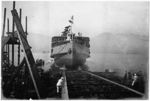Kinling
Contents
History
1904. Launched as "Shanghai" , but almost immediately afterwards the name was changed to "Kinling".
May 19th.1916. Went on fire at Kiangyin on the lower Yangtse river, the passenger accommodation being destroyed.
May 25th. 1916. Arrived under tow at Shanghai. The hulk was sold to Nisshin Kisen Kabrurika Kaisya, Tokyo, who had her rebuilt by the Shanghai Dock and Engineering Co. Renamed "Suiyang Maru" and re-entering service on 30th. Aug 1917.
Aug 18th. 1937. Vessel seized by the Chinese Gov't and sunk as a blockship across the Whangpu river, Shanghai.
Service
Shallow draught vessel employed on the Yangtse river services.
Events / Stories
The Mystery of Shanghai
This dramatic photograph shows the Yangtze River steamer Shanghai, built at Hongkong & Whampoa Dockyard’s (“HWD”) Kowloon Dock, and launched by Lady William Meigh Goodman, wife of the Chief Justice, on 14th July 1904. At the time, Shanghai was the largest vessel ever built in Hong Kong – a proud day indeed for CNCo and for HWD.
The only problem is that so far as CNCo’s records are concerned, this vessel never existed: the only Shanghai to join the CNCo fleet was a paddlesteamer built in Glasgow in 1873 – so what on earth became of her 1904 namesake? To add to the mystery, a Kowloon Dock-built steamer – identical in every respect, but named Kinling – joined CNCo’s lower Yangtze service in September 1904. The briefest of mentions in the North China Herald of 9th September 1904 confirms these two vessels were in fact one and the same: “The name of the new China Navigation river steamer built at Hongkong is said to have been changed to Kinling...”
But why the eleventh-hour change? With no hard evidence, we believe the answer lies in the fate of her predecessor, the paddle-steamer Shanghai. On Christmas Day 1890, that vessel went up in flames on the Yangtze; between 200 and 300 passengers were burnt to death or drowned and those who made it ashore were beaten and robbed by local villagers. Believed to be the result of arson, the loss of Shanghai was an unprecedented tragedy. Even 14 years later on, this horrific event must have been fresh in the minds of travellers. So when news of the launch of Shanghai II reached her namesake city, it’s likely Swire’s Chinese staff had quite a bit to say about the ill-chosen name – predicting the new ship would never carry passengers unless there was a change.
As for Kinling, sadly, some of Shanghai’s ‘bad joss’ seems to have rubbed off: within six months the vessel was reported grounded, with a rock through her bottom, and in May 1916, she, too, was badly damaged by fire and subsequently sold.



